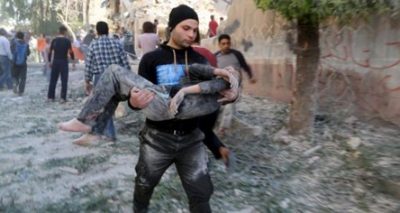Deaths in Raqqa as a Result of Mines Left Behind by ISIS
Although ISIS militants have been defeated in Raqqa, the mines and IEDs they left behind continue to take innocent people's lives

Over the course of 2017, ISIS’ presence in eastern Syria has collapsed. Once the dominant power in the provinces of Deir ez-Zour and Raqqa, the militant group’s territory has diminished steadily as a result of the military operations of the Syrian Arab Army (SAA) in the south and the Syrian Democratic Forces (SDF) in the north. However, even in defeat, the militant group has managed to unleash misery upon the Syrian people, in the form of landmines and IEDs.
Over the course of its three-year rule in Iraq and Syria, ISIS has made copious use of landmines, IEDs and booby traps. Many of the militants were experts in building sophisticated explosive devices to bolster their defensive capabilities. They would hide these explosives in roads and houses, slowing down the advance of their enemies and dissuading civilians from escaping. By rigging up homes and vital infrastructure, the group also ensured that their bombs would double as a device for its scorched earth tactics, ensuring that towns and cities would be too devastated or dangerous to re-inhabit in the wake of their retreat.
Since the liberation of Raqqa from ISIS, the SDF has been working to clear the mines left behind by the militants in a bid to allow for the safe return of local residents. However, the group lacks the sophisticated equipment and know-how to dismantle some of ISIS’ most sophisticated mines, such as the dreaded “Russian Dish” model. Forced to dismantle mines in primitive conditions, the SDF lost many fighters to such explosives.
It is not just SDF fighters who have been killed. The mines have killed numerous Raqqa residents as well. Many of them had returned the city before the SDF gave the all-clear. They are fully aware that their homes might be rigged with explosives and are willing to take the risk. Still, the rising death toll leaves one to wonder if the risk was worth the cost. It is believed that some 120 people, both civilians and SDF fighters, have been killed since anti-ISIS operations in Raqqa came to an end. This weekend alone saw two people in Raqqa killed and seven others injured when they triggered a mine.
The United Nations warns that unexploded ordnance can pose a risk for up to five decades. Indeed, there are many countries around the world that continue to be haunted by landmines decades after their own conflicts came to an end. In Syria, preventing such devices from taking lives down the years will need funding, equipment and training. Alas so far, many parts of the country have access to none.

